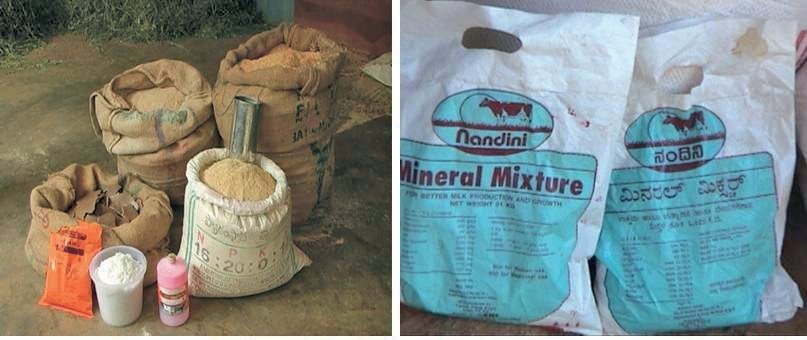Feed and Fodder Management
- A scientific feeding pattern will ensure adequate nutrition and consequently proper growth of the dairy animal.
- The diet must comprise approximately 60-70% of green fodder, 20-30% of dry fodder and 5-10% of concentrate/supplementary feed.
- The diet should provide about 16-20% of Crude Protein (CP) and 65% of Crude Fibre (CF).
- Additional concentrate/supplementary feeding must be provided to pregnant and lactating animals.
- Low grade roughage/residues can be used, but have to be treated through physical and mechanical methods (soaking, chopping, grinding, pelleting, steaming and irradiation); chemical methods (sodium hydroxide,urea/ammonia, etc.) and biological methods (fungi).
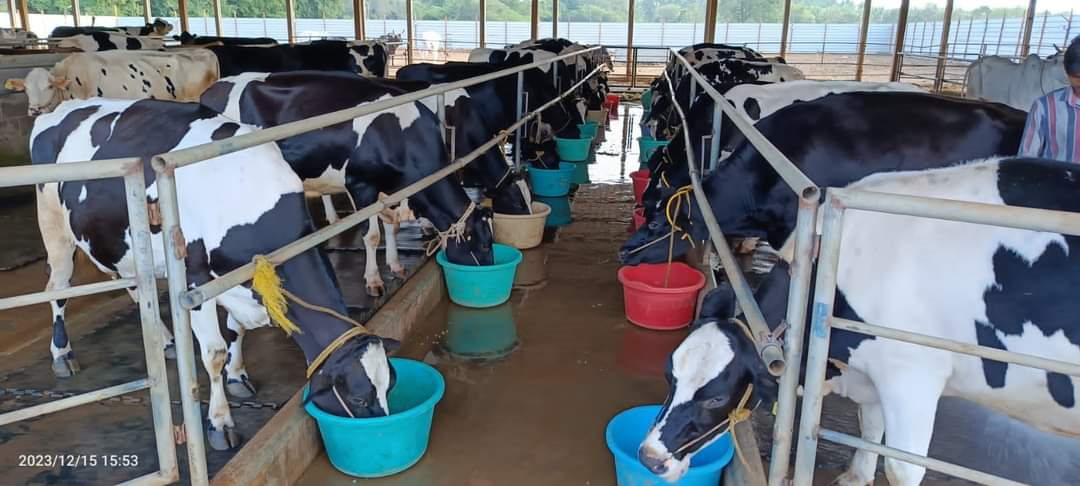
Feeding of Colostrums
It will vary with the system followed, but whatever system may be practiced, the calf must receive the first milk which the cow gives after calving and is called colostrums. Be sure to feed the calf enough of colostrums between 2 to 2.5 liters daily for the first 3 days following its birth.
Any excess colostrum may be fed to other calves in the herd in amounts equal to the amount of whole milk normally fed. If possible where a cow is milked before calving, freeze some of the colostrums for later feeding to the calf. None of it should be wasted. The digestibility of colostrums increases when it is given at a temperature between 99oF and 102oF. The importance of colostrums can be felt more from the following virtues.
The protein of colostrums consists of a much higher proportion of globulin than doe’s normal milk. The globulins are presumed to be the source of antibodies which aid in protecting the animal from many infections liable to affect it after birth. Gamma - globulin level in blood serum of neonatal calves is only 0.97 mg/ml at birth. It increase to 16.55 mg/ml level after first colostrums feeding at 12 hr and subsequently on the second day shows a peak of 28.18 mg/ml. This level more or less persists till the reticulo-endothelial system of the calf starts functioning to produce antibodies.
- The protein content of colostrums is 3 to 5 times as that of normal milk. It is also rich in some of the materials, of which copper, iron, magnesium and manganese are important.
- Colostrums contain 5-15 times the amount of Vitamin A- found in normal milk, depending upon the character of the ration given to the mother during the rest period.
- Colostrums is also superior to milk in having a considerably greater amount of several other vitamins which have been found essential in the growth of dairy calves, including riboflavin, choline, thiamine and pantothenic acid.
- Colostrums act as a laxative to free the digestive tract of faecal material.

Feeding allowances for dairy cattle and buffaloes. |
||||
|---|---|---|---|---|
| Type of animal | Yield of the animal | Green fodder (kg/day/ animal) | Dry fodder (kg/day/ animal) | Concentrates (kg/day/ animal) |
| Cow | less than 5 litres/day | 10-12 | 5.0 | 2.0/ |
| 5-10 litres/day | 14-16 | 5.5 | 4.0/ | |
| Cow in gestation | 15.0 | 5.0 | 1.5 | |
| Buffalo | less than 5 litres/day | 10-12 | 5.0 | 2.5 |
| 5-10 litres/day | 14-16 | 6.0 | 5.0 | |
| >10 litres/day | 18-20 | 7.0 | 6.0 | |
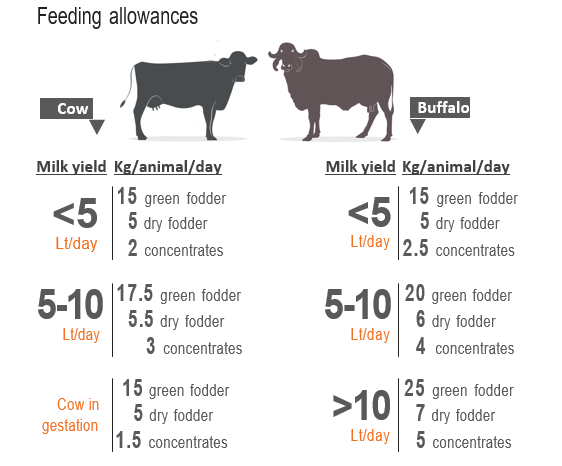
| Nutrient composition (%) for every 100 kg of supplementary feed (concentrate mixture) for dairy animals. | |
|---|---|
| Ingredients | Per 100 kg |
| Maize/ soybean/green gram/cereals (broken/ ground/mashed) | 30-40 |
| Any oil cakes | 20-30 |
| Husk/bran | 30-40 |
| Mineral mixture & salt | 1-2 |
| Total | 100 |
5 a. Classification of Green Fodder Crops
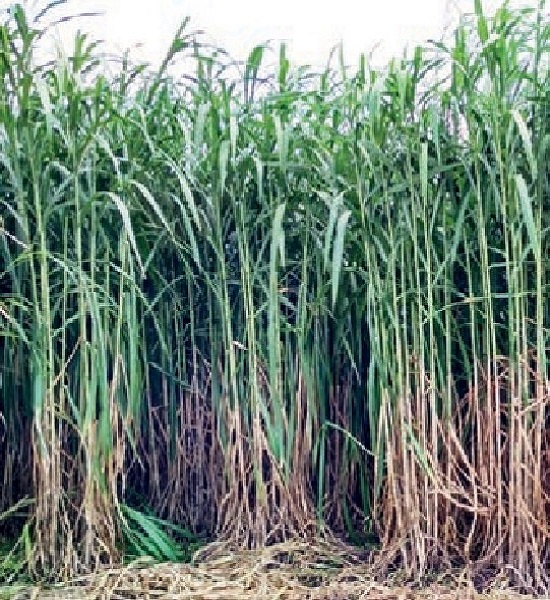
Hybrid Napier
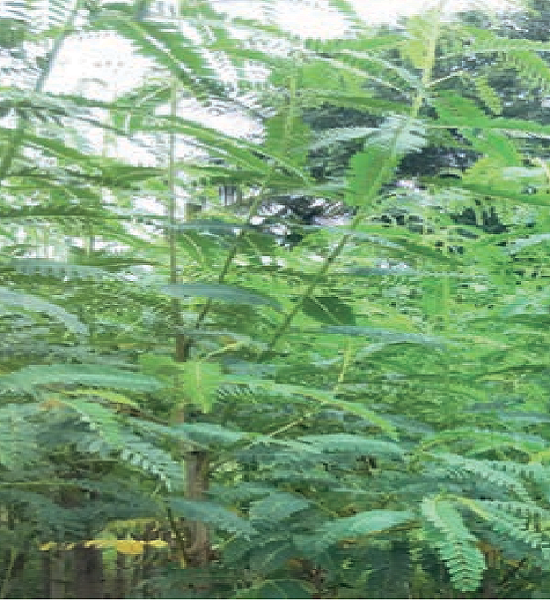
Sesbania
5 b.Fodder Chaffing
- This is the process of cutting fodder into 1-2 inch pieces so that wastage can be minimized by about 40-50%, ensuring maximum utilization.
- Not only does it increase feed palatability; it also substantially reduces rumination time and storage space.
5 c.Silage Making
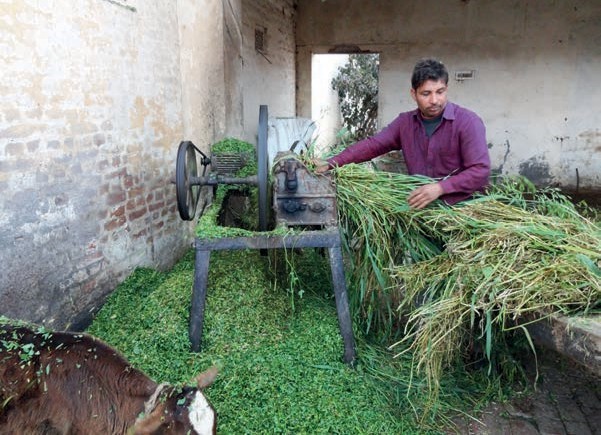
Minimizing wastage by chaffing
- Silage comes in handly during times of fodder scarcity.
- Silage can be made with thick stem crops like sorghum, maize, pearl millet, Napier and various legumes.
- The crop should be harvested at 50% flowering to milk or dough stage for quality silage.
- Ensiling can be done under anaerobic conditions for 45 days in pits, trenches, bunkers and tower silos of different types and sizes. Lately, silo bags of various sizes (100 kg, 200 kg, 500 kg and 1000 kg) are also available.
- Inoculums can be used to enhance ensiling rate.
- A total of 500 kg of green fodder can be ensiled in a 1 cubic metre pit.
- On an average, 20-25 kg of silage can be fed to an adult cattle/buffalo per day.
- Good silage is golden brown or greenish yellow with a pleasant fruity odor, has no mould growth, is palatable and has a pH of around 4.0-4.5.
- Silage making ensures the regular supply of quality fodder during lean periods and enhances green fodder productivity by improving harvesting intensity.
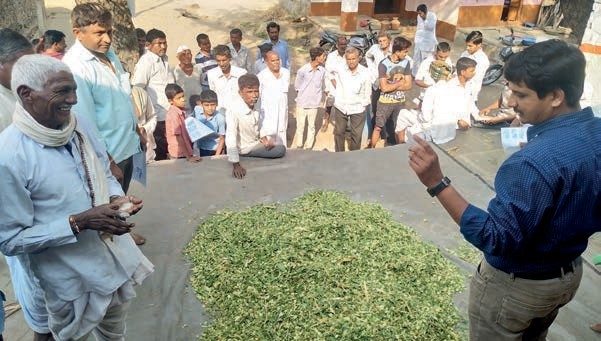
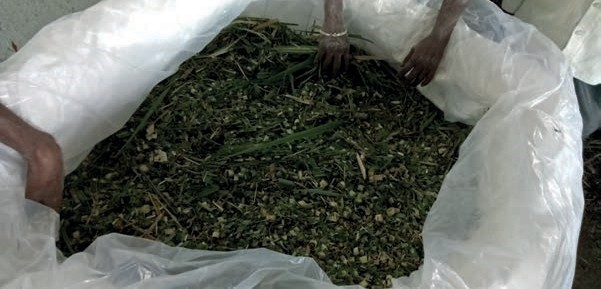
5 d.Hay Making
- Hay is stored forage that has low moisture content (10-15 %). Legume hay, non-legume hay and mixed hay are the three major types of hay.
- Hay making is the most common and easy way of preserving the seasonal excess of green fodder. The herbage’s low moisture enables its storage without fermentation or mould formation.
- For hay making, harvesting must be done after the dew has dried up.
- The harvested fodder has to be allowed to cure in the field, and turned every 4-5 hours for 1-2 days, to reduce moisture content to around 10-15 %, following which it can be stored.
- Nutrient loss may occur due to late cutting of hay, shattering of leaves and finer parts especially in legumes, oxidation loss by sun bleaching and leaching leading to loss of protein, resulting in major losses.
5 e.Enriching Dry Fodder
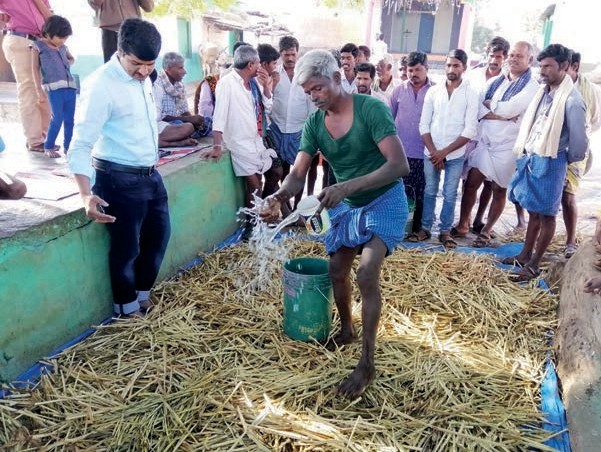
5 f. Azolla Feed
- Azolla is a small, aquatic floating fern that lives in symbiosis with nitrogen fixing blue-green algae that grow naturally in stagnant drains, canals, ponds, rivers, etc.
- Its nutrient composition makes it a highly efficient and easily digestible feed for livestock.
- Azolla doubles its weight in 3-5 days. Its fresh weight can go from 1 t/ha to 15-20 t/ha in about 20 days.
- On dry weight basis, it contains 25-35% protein, 10-15% minerals, 7-10% amino acids, bio-active substances and biopolymers. It has very low carbohydrate and fat.
- It is one of the most economical feed substitutes, since it can be easily digested by livestock due to its high protein and low lignin content.
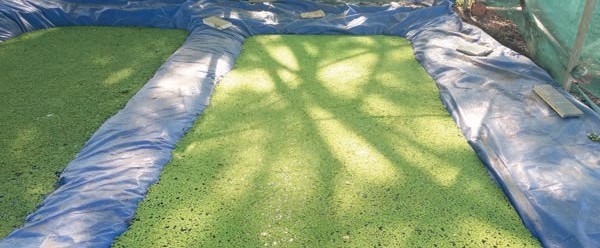
Azolla: An economical feed substitute
5 g.Area Specific Mineral Mixture (ASMM)
- Feed and fodder fed to dairy animals do not provide all the minerals required. Hence, their diet should be supplemented with adequate amount of good quality mineral mixture.
- Level of minerals in feeds and fodder varies from region to region, thus mineral availability to the animal also varies. So, it is necessary to produce region specific mineral mixture accordingly.
- The major minerals required are calcium, phosphorous, magnesium, potassium, sodium, chlorine and sulphur.
- The trace minerals required are iron, zinc, manganese, copper, iodine, cobalt and selenium. Mineral mixtures contain these minerals.
- 50-200 g of area specific mineral mixture has to be fed daily depending on the age and condition of the animal.
- Its benefits include swifter growth of calves, reproduction efficiency, efficiency of feed utilization, early puberty, reduced inter-calving period, improved milk production and Solids Not Fat (SNF) content of the milk, and better resistance to diseases.
